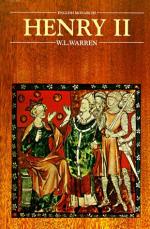We see everywhere, in fact, signs of the great contest which in one form or another runs through the whole of the twelfth century, and gives its main interest in our eyes to the English history of the time,—the struggle between the iron organization of medieval feudalism and those nascent forces of modern civilization which were fated in the end to shatter and supersede it. In spite of the cry of lamentation which the chroniclers carry down to us over the misery of a land stricken by plague and famine and rapine, it is still plain that even through the terrible years of Stephen’s reign England had its share in the universal movement by which the squalor and misery of the Middle Ages were giving place to a larger activity and a better order of things A class unknown before was fast growing into power,—the middle class of burghers and traders, who desired above all things order, and hated above all things the medieval enemy of order, the feudal lord. Merchant and cultivator and wool-grower found better work ready to their hand than fighting, and the appearance of mercenary soldiers marked everywhere the development of peaceful industries. Amid all the confusion of civil war the industrial activities of the country had developed with bewildering rapidity; while knights and barons led their foreign hirelings to mutual slaughter, monks and canons were raising their religious houses in all the waste places of the land, and silently laying the foundations of English enterprise and English commerce. To the great body of the Benedictines and the Cluniacs were added in the middle of the twelfth century the Cistercians, who founded their houses among the desolate moorlands of Yorkshire in solitary places which had known no inhabitants since the Conqueror’s ravages, or among the swamps of Lincolnshire. A hundred and fifteen monasteries were built during the nineteen years of Stephen’s reign, more than had been founded in the whole previous century; a hundred and thirteen were added to these during the reign of Henry. In half a century sixty-four religious houses were built in Yorkshire and Lincolnshire alone. Monastery and priory, in which the decorated Romanesque was giving way to the first-pointed architecture, towered above the wretched mud-hovels in which the whole of the population below the class of barons crowded; their churches were distinguished by the rare and novel luxury of glass windows, which, as they caught the red light of the setting sun, startled the peasant with omens of coming ill. Multitudes of men were busied in raising the vast pile of buildings which made up a religious house,—cloisters, dormitories, chapels, hospitals, granaries, barns, storehouses, whose foundations when all else is gone still show in the rugged surface of some modern field. Regular and secular clergy were alike spurred on in their work by jealous rivalry. Archbishop Roger of York was at the opening of Henry’s reign building his beautiful church at Ripon, of whose rich decoration traces still remain, while he gave scant sympathy and encouragement to the Cistercian monks still busy with the austere mass of buildings which they had raised at Fountains almost within sight of the Ripon towers.




